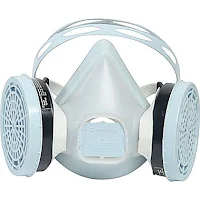Comparison of Protection Factors Offered by N95 and P100 Filtering Facepiece and Elastomeric Half-Mask Respirators
 |
| staples.com |
Twenty-five human test subjects performed modified OSHA fit test exercises in a controlled laboratory environment with the N95 respirators (two FFR models and two EHR models) and the P100 respirators (two FFRs and two EHRs). Two Scanning Mobility Particle Sizers (SMPS) were used to measure aerosol concentrations (in the 10–400 nm size range) inside (Cin) and outside (Cout) of the respirator, simultaneously. SWPF was calculated as the ratio of Cout to Cin. The SWPF values obtained from the N95 respirators were then compared to those of the P100 respirators.
SWPFs were found to be significantly different (P<0.05) between N95 and P100 class respirators. The 10th, 25th, 50th, 75th and 90th percentiles of the SWPFs for the N95 respirators were much lower than those for the P100 models. The N95 respirators had 5th percentiles of the SWPFs > 10. In contrast, the P100 class was able to generate 5th percentiles SWPFs > 100. No significant difference was found in the SWPFs when tested against nano-size (10 to 100 nm) and large-size (100 to 400 nm) particles.
Overall, the findings suggest that the two FFRs and two EHRs with P100 class filters provide better performance than those with N95 filters against particles from 10 to 400 nm, supporting current OSHA and NIOSH recommendations.
Keywords: Nano particle, N95, P100, FFR, HER, SWPF, Respirator
REFERENCE:
He, Xinjian et al. “Comparison of Simulated Workplace Protection Factors Offered by N95 and P100 Filtering Facepiece and Elastomeric Half-Mask Respirators against Particles of 10 to 400 Nm.” Journal of nanotechnology and materials science 2.2 (2015): 1–6. PMC. Web. 22 Oct. 2015.
-----------------------------------------------------------
Sigue este Blog en Facebook y Twitter



Comentarios